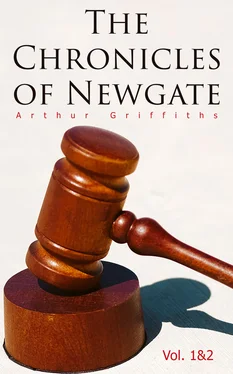Duval did not long honour his native country with his presence. On the restoration of Charles II. he came to London as footman to a person of quality; but soon took to the road. Numerous stories are told of his boldness, his address, and fertility of resource. One of the most amusing is that in which he got an accomplice to dress up a mastiff in a cow’s-hide, put horns on his head, and let him down a chimney into a room where a bridal merry-making was in progress. Duval, who was one of the guests, dexterously profited by the general dismay to lighten the pockets of an old farmer whom he had seen secreting a hundred pounds. When the money was missed it was supposed that the devil had flown away with it. On another occasion, having revisited France, he ingratiated himself with a wealthy priest by pretending to possess the secret of the philosopher’s stone. This he effected by stirring up a potful of molten inferior metal with a stick, within which were enclosed a number of sprigs of pure gold, as black lead is in a pencil. When the baser metals were consumed by the fire, the pure gold remained at the bottom of the pot. Overjoyed at Duval’s skill as an alchemist, the priest made him his confidant and bosom friend, revealing him his secret hoards, and how they were bestowed. One day, when the priest was asleep after dinner, Duval gagged and bound him, removed his keys, unlocked his strong boxes, and went off with all the valuables he could carry. Duval was also an adroit card-sharper, and won considerable sums at play by “slipping a card”; and he was most astute in laying and winning wagers on matters he had previously fully mastered. His career was abruptly terminated by his capture when drunk at a tavern in Chandos St., and he was executed, after ten years of triumph, at the early age of twenty-seven.
William Nevison, a native-born member of the same fraternity, may be called, says Raine, “the Claude Duval of the north. The chroniclers of his deeds have told us of his daring and his charities, for he gave away to the poor much of the money he took from the rich.” Nevison was born at Pontefract in 1639, and began as a boy by stealing his father’s spoons. When chastised by the schoolmaster for this offence, he bolted with his master’s horse, having first robbed his father’s strong box. After spending some time in London thieving, he went to Flanders and served, not without distinction, in a regiment of English volunteers commanded by the Duke of York. He returned presently to England, and took to the road. Stories are told of him similar to those which made Duval famous. Nevison was on the king’s side, and never robbed Royalists. He was especially hard on usurers. On one occasion he eased a Jew of his ready money, then made him sign a note of hand for five hundred pounds, which by hard riding he cashed before the usurer could stop payment. Again, he robbed a bailiff who had just distrained a poor farmer for rent. The proceeds of the sale, which the bailiff thus lost, Nevison restored to the farmer. In the midst of his career, having made one grand coup , he retired from business and spent eight years virtuously with his father. At the old man’s death he resumed his evil courses, and was presently arrested and thrown into Leicester Gaol. From this he escaped by a clever stratagem. A friendly doctor having declared he had the plague, gave him a sleeping draught, and saw him consigned to a coffin as dead. His friend demanded the body, and Nevison passed the gates in the coffin. Once outside, he was speedily restored to life, and resumed his old ways. He now extended his operations to the capital, and it was soon after this that he gained the soubriquet, given by Charles II., it is said, of “Swift Nick.” There seems to be very little doubt that Nevison was actually the hero of the great ride to York, commonly credited to Turpin. The story goes that he robbed a gentleman at Gadshill, then riding to Gravesend, crossed the Thames and galloped across Essex to Chelmsford. After baiting he rode on to Cambridge, and Godmanchester, thence to Huntingdon, where he baited his mare and slept for an hour; after that, holding to the north road, and not galloping his horse all the way, reached York the same afternoon. Having changed his clothes, he went to the bowling-green, where he made himself noticeable to the Lord Mayor. By and by, when recognized and charged with the robbery at Gadshill, Nevison called upon the mayor to prove that he had seen him at York; whereupon he was acquitted, “on the bare supposition that it was impossible for a man to be at two places so remote on one and the same day.”
Nevison appears to have been arrested and in custody in 1676. He was tried for his life, but reprieved and drafted into a regiment at Tangier. He soon deserted, and returning to England, again took to the road. He was next captured at Wakefield, tried, and sentenced to death; but escaped from prison, to be finally taken up for a trifling robbery, for which he suffered at York. The depositions preserved by the Surtees’ Society show that he was the life and centre of a gang of highway robbers who worked in association. They levied black mail upon the whole country side; attended fairs, race meetings, and public gatherings, and had spies and accomplices, inn-keepers and ostlers, who kept them informed of the movements of travellers, and put them in the way of “likely jobs” to be done. Drovers and farmers who paid a tax to them escaped spoliation; but all others were very roughly handled. The gang had its head-quarters at the Talbot Inn, Newark, where they kept a room by the year, and met at regular intervals to divide the proceeds of their robberies.
Many instances are recorded of another crime somewhat akin to highway robbery. The forcible abduction of heiresses was nothing new; but it was now prosecuted with more impudence and daring than heretofore. Luttrell tells us, under date 1st June, 1683, that one Mrs. Synderfin, a rich widow, was taken out of her carriage on Hounslow Heath, by a Captain Clifford and his comrades. They carried her into France to “Calice” against her will, and with much barbarous ill-usage made her marry Clifford. Mrs. Synderfin or Clifford was, however, rescued, and brought back to England. Clifford escaped, but presently returning to London was seized and committed to custody. He pleaded in defence his great passion for the lady, and his “seeing no other way to win her.” It was not mere fortune-hunting, he declared, as he possessed a better estate than hers. But the Lord Chief Justice charged the jury that they must find the prisoners guilty, which they did, and all were sentenced to imprisonment in Newgate for one year. Captain Clifford was also to pay a fine of £1000, two of his confederates £500 each, and two more £100. In the same authority is an account how—“Yesterday a gentleman was committed to Newgate for stealing a young lady worth £10,000, by the help of bailiffs, who arrested her and her maid in a false action, and had got them into a coach, but they were rescued.” Again, a year or two later, “one Swanson, a Dane, who pretends to be a Deal merchant, is committed to Newgate for stealing one Miss Rawlins, a young lady of Leicestershire, with a fortune of £4000. Three bailiff’s and a woman, Swanson’s pretended sister, who assisted, are also committed, they having forced her to marry him. Swanson and Mrs. Bainton were convicted of this felony at the King’s Bench Bar; but the bailiffs who arrested her on a sham action were acquitted, with which the court was not well pleased. Swanson was sentenced to death, and executed. As also the woman; but she being found with child, her execution was respited.” A more flagrant case was the abduction of Miss Mary Wharton in 1690, the daughter and heiress of Sir George Wharton, by Captain James Campbell, brother to the Earl of Argyll, assisted by Sir John Johnson. Miss Wharton, who was only thirteen years of age, had a fortune of £50,000. She was carried away from her relations in Great Queen Street, on the 14th Nov., 1690, and married against her will. A royal proclamation was forthwith issued for the apprehension of Captain Campbell and his abettors. Sir John Johnson was taken, committed to Newgate, and presently tried and cast for death. “Great application was made to the king and to the relations of the bride to save his life,” but to no purpose, “which was thought the harder, as it appeared upon his trial that Miss Wharton had given evident proof that the violence Captain Campbell used was not so much against her will as her lawyers endeavoured to make it.” Luttrell says, “Sir John refused pardon unless requested by the friends of Mrs. Wharton. On the 23rd December he went in a mourning coach to Tyburn, and there was hanged.” No mention is made of the arrest of Captain Campbell, whom we may conclude got off to the continent. But he benefited little by his violence, for a bill was brought into the House of Commons within three weeks of the abduction to render the marriage void, and this, although the Earl of Argyll on behalf of his brother petitioned against it, speedily passed both Houses.
Читать дальше












